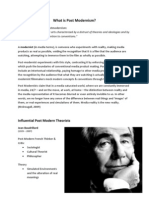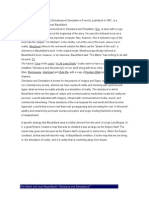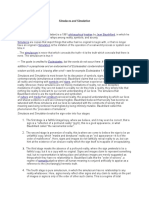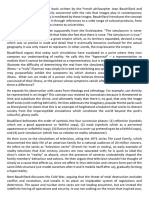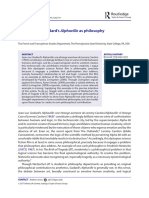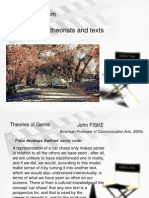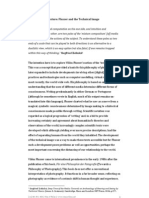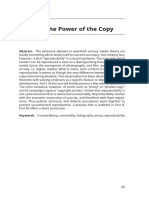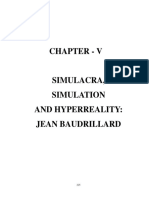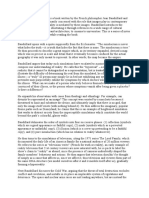Simulacrum Aa
Simulacrum Aa
Uploaded by
JUANJOSEFOXCopyright:
Available Formats
Simulacrum Aa
Simulacrum Aa
Uploaded by
JUANJOSEFOXOriginal Description:
Original Title
Copyright
Available Formats
Share this document
Did you find this document useful?
Is this content inappropriate?
Copyright:
Available Formats
Simulacrum Aa
Simulacrum Aa
Uploaded by
JUANJOSEFOXCopyright:
Available Formats
Fredric Jameson offers photorealism as an example of artistic simulacrum, where a painting is
created by copying a photograph that is itself a copy of the real.[3] Other art forms that play with
simulacra include trompe-l'œil,[4] pop art, Italian neorealism, and French New Wave.[3]
Contents
1Philosophy
2Recreation
3Caricature
4Iconography
5Word usage
6Simulacrum as artificial beings
7See also
8References
9External links
Philosophy[edit]
Simulacra have long been of interest to philosophers. In his Sophist, Plato speaks of two kinds of
image-making. The first is a faithful reproduction, attempted to copy precisely the original. The
second is intentionally distorted in order to make the copy appear correct to viewers. He gives the
example of Greek statuary, which was crafted larger on the top than on the bottom so that viewers
on the ground would see it correctly. If they could view it in scale, they would realize it was
malformed. This example from the visual arts serves as a metaphor for the philosophical arts and
the tendency of some philosophers to distort the truth so that it appears accurate unless viewed from
the proper angle.[5] Nietzsche addresses the concept of simulacrum (but does not use the term) in
the Twilight of the Idols, suggesting that most philosophers, by ignoring the reliable input of their
senses and resorting to the constructs of language and reason, arrive at a distorted copy of reality.[6]
Postmodernist French social theorist Jean Baudrillard argues that a simulacrum is not a copy of the
real, but becomes truth in its own right: the hyperreal. According to Baudrillard, what the simulacrum
copies either had no original or no longer has an original (think a copy of a copy without an original).
Where Plato saw two types of representation—faithful and intentionally distorted (simulacrum)—
Baudrillard sees four: (1) basic reflection of reality; (2) perversion of reality; (3) pretence of reality
(where there is no model); and (4) simulacrum, which "bears no relation to any reality whatsoever".
[7]
In Baudrillard's concept, like Nietzsche's, simulacra are perceived as negative, but another modern
philosopher who addressed the topic, Gilles Deleuze, takes a different view, seeing simulacra as the
avenue by which an accepted ideal or "privileged position" could be "challenged and overturned".
[8]
Deleuze defines simulacra as "those systems in which different relates to different by means
of difference itself. What is essential is that we find in these systems no prior identity, no internal
resemblance".[9]
Alain Badiou, in speaking with reference to Nazism about Evil, writes,[10] "fidelity to a simulacrum,
unlike fidelity to an event, regulates its break with the situation not by the universality of the void, but
by the closed particularity of an abstract set ... (the 'Germans' or the 'Aryans')".
You might also like
- Philosophy Mind Book Chalmers PDFDocument687 pagesPhilosophy Mind Book Chalmers PDFjazmina100% (8)
- Claire Bishop-Heightened PerceptionDocument33 pagesClaire Bishop-Heightened PerceptionLa Galeria de Comercio100% (1)
- An Eternal Esthetics of Laborious GesturesDocument13 pagesAn Eternal Esthetics of Laborious GesturesJohannes de SilentioNo ratings yet
- What Is Post ModernismDocument3 pagesWhat Is Post ModernismMichael RaucciNo ratings yet
- Joel Feinberg The Nature and Value of RightsDocument2 pagesJoel Feinberg The Nature and Value of Rightsmartin100% (1)
- Simulacrum ADocument1 pageSimulacrum AJUANJOSEFOXNo ratings yet
- SimulacrumDocument1 pageSimulacrumJUANJOSEFOXNo ratings yet
- Simulacra and Simulation BackgroundDocument34 pagesSimulacra and Simulation BackgroundFreángel Pacheco67% (3)
- Realer Than RealDocument9 pagesRealer Than RealInês DuarteNo ratings yet
- Simulacra and SimulationDocument3 pagesSimulacra and SimulationAlexandra IliescuNo ratings yet
- 67 - Gayadri DeviDocument12 pages67 - Gayadri Devi_the_bridge_No ratings yet
- Massumi. The Simulacrum According To Deleuze and Guatarri 1Document3 pagesMassumi. The Simulacrum According To Deleuze and Guatarri 1Alexander CancioNo ratings yet
- Briam Massumi - Simulacrum by Deleuze and Guattari PDFDocument16 pagesBriam Massumi - Simulacrum by Deleuze and Guattari PDFdanieldimoNo ratings yet
- Simulacra and SimulationDocument5 pagesSimulacra and Simulationfadzil yusof50% (4)
- HyperrealityDocument1 pageHyperrealityCAMELIA BELGHAZINo ratings yet
- Simulation, Simulacrum 2Document4 pagesSimulation, Simulacrum 2morgan385No ratings yet
- Literature Essay Final 2Document15 pagesLiterature Essay Final 2Gheorghe ȘepteliciNo ratings yet
- Simulacra and Simulation For Studetns PDFDocument5 pagesSimulacra and Simulation For Studetns PDFkomalthakur018No ratings yet
- Art and Logic Godard's Alphaville As PhilosophyDocument18 pagesArt and Logic Godard's Alphaville As PhilosophyJimNo ratings yet
- Postmodernism - Theory, Theorists and TextsDocument30 pagesPostmodernism - Theory, Theorists and TextsadanicNo ratings yet
- Aureli The Solitude of The ProjectDocument13 pagesAureli The Solitude of The ProjectPabloNo ratings yet
- A Concretising Gesture - Flusser and The Technical ImageDocument11 pagesA Concretising Gesture - Flusser and The Technical ImageAna Caria PereiraNo ratings yet
- "The Avant-Garde and Its Imaginary," by Constance PenleyDocument32 pages"The Avant-Garde and Its Imaginary," by Constance PenleyChristoph CoxNo ratings yet
- Discuss Jean Baudrillard - Docx-LibreDocument13 pagesDiscuss Jean Baudrillard - Docx-LibreMc Vharn CatreNo ratings yet
- D Limiting The Power of TheDocument18 pagesD Limiting The Power of TheIosifNo ratings yet
- Simulacra and SimulationDocument53 pagesSimulacra and Simulationdhileep.bhashyam kumar100% (4)
- Jean BaudrillardDocument5 pagesJean BaudrillardKARTHIKEYANI SNo ratings yet
- Reality and Identity in NolanDocument4 pagesReality and Identity in NolanAdisa EjubovicNo ratings yet
- Simulacra and Simulation NotesDocument5 pagesSimulacra and Simulation NotesTothKKittiNo ratings yet
- SimulacraDocument5 pagesSimulacravjencoNo ratings yet
- Towards A Solaristic Philosophy of Film PDFDocument11 pagesTowards A Solaristic Philosophy of Film PDFMouaci NwlNo ratings yet
- Mise en Abyme (Engl.)Document5 pagesMise en Abyme (Engl.)Jean-Charles CanosseNo ratings yet
- Surrealist CinemaDocument27 pagesSurrealist CinemaRebekah WalterNo ratings yet
- 08 - Chapter 1 PDFDocument25 pages08 - Chapter 1 PDFJesus GomesNo ratings yet
- Chapter 4 5 Philosophy Culture Language and ArtDocument9 pagesChapter 4 5 Philosophy Culture Language and ArtPeter paul OtadoyNo ratings yet
- Lopez, M-Weekly Reading Journal (Week 14) Post 911 DesignDocument4 pagesLopez, M-Weekly Reading Journal (Week 14) Post 911 Designlopezmeli2002No ratings yet
- Surrealism and CinemaDocument15 pagesSurrealism and Cinemasoham ghoshNo ratings yet
- Caillois's BiologyDocument19 pagesCaillois's Biologyfrancesca.b7No ratings yet
- Kinowa Materialność Teorii DeleuzeDocument36 pagesKinowa Materialność Teorii DeleuzeSofa z IkeiNo ratings yet
- Fields of Sense Review On GabrielDocument9 pagesFields of Sense Review On GabrielMartin JeanNo ratings yet
- An Eternal Esthetics of Laborious GesturesDocument13 pagesAn Eternal Esthetics of Laborious GesturesJesse LernerNo ratings yet
- Convulsive IdentityDocument38 pagesConvulsive Identitybaba.carmoNo ratings yet
- Hypothesis of The Stolen AestheticsDocument10 pagesHypothesis of The Stolen Aestheticschuma_riescoNo ratings yet
- HyperrealityDocument13 pagesHyperrealityMichael Vince AlvarezNo ratings yet
- Spectacle: Spectãre (To Look) - The Oxford English Dictionary Reports That ADocument5 pagesSpectacle: Spectãre (To Look) - The Oxford English Dictionary Reports That Amorgan385No ratings yet
- Taylor - Ricoeur Philosophy of ImaginationDocument12 pagesTaylor - Ricoeur Philosophy of ImaginationkobarnaNo ratings yet
- Dialectics of The FableDocument10 pagesDialectics of The FableGabrielGaunyNo ratings yet
- Film Essay QuotesDocument1 pageFilm Essay Quotesbenwilson_95No ratings yet
- UNIT III - Film StudiesDocument6 pagesUNIT III - Film StudiesshutupiqraNo ratings yet
- Introduction of The Architecture of The ImaginationDocument21 pagesIntroduction of The Architecture of The ImaginationIván RodríguezNo ratings yet
- Postmodernist Cinema and Questions of RealityDocument23 pagesPostmodernist Cinema and Questions of RealitythepolymathNo ratings yet
- Thoughts On Simulacrum: Semiotics Postmodernism Consciousness RealityDocument2 pagesThoughts On Simulacrum: Semiotics Postmodernism Consciousness RealitygraceyyyNo ratings yet
- Aesthetics of Fake An OverviewDocument11 pagesAesthetics of Fake An OverviewAjvaro ContiNo ratings yet
- Unit Iv-Film StudiesDocument7 pagesUnit Iv-Film StudiesshutupiqraNo ratings yet
- Lovejoy VisionRepresentationDocument8 pagesLovejoy VisionRepresentationLizNo ratings yet
- Larrson - Didi Warburg BenjaminDocument10 pagesLarrson - Didi Warburg BenjaminMariana AguirreNo ratings yet
- Mimes IsDocument14 pagesMimes IsVinayak Rama VarmaNo ratings yet
- The Suture or The Logic of The Signifier in Cahiers Du CinémaDocument2 pagesThe Suture or The Logic of The Signifier in Cahiers Du Cinématomgun11100% (1)
- Jon Geib. Poetic IncommunicabilityDocument8 pagesJon Geib. Poetic IncommunicabilityLDNo ratings yet
- Virtual Photography: Artificial Intelligence, In-game, and Extended RealityFrom EverandVirtual Photography: Artificial Intelligence, In-game, and Extended RealityAli ShobeiriNo ratings yet
- Simulacrum: Exploring the Possibility of a Simulated RealityFrom EverandSimulacrum: Exploring the Possibility of a Simulated RealityNo ratings yet
- N The Mathematically Rigorous Formulation of Quantum MechanicsDocument1 pageN The Mathematically Rigorous Formulation of Quantum MechanicsJUANJOSEFOXNo ratings yet
- QUANTIMINDocument1 pageQUANTIMINJUANJOSEFOXNo ratings yet
- Quantum Mechanics4Document1 pageQuantum Mechanics4JUANJOSEFOXNo ratings yet
- Quantum Mechanics2Document1 pageQuantum Mechanics2JUANJOSEFOXNo ratings yet
- Internationally Educated Nurses, NCLEX-RN, Nursing EducationDocument1 pageInternationally Educated Nurses, NCLEX-RN, Nursing EducationJUANJOSEFOXNo ratings yet
- Etymology: Pneumonoultramicroscopicsilicovolcanoconiosis (Document1 pageEtymology: Pneumonoultramicroscopicsilicovolcanoconiosis (JUANJOSEFOXNo ratings yet
- Course C - Drug EducDocument7 pagesCourse C - Drug EducJUANJOSEFOX100% (1)
- D. Identify If It Is The Disease Which It Is Reported To BeDocument17 pagesD. Identify If It Is The Disease Which It Is Reported To BeJUANJOSEFOXNo ratings yet
- Showing Our LoveDocument2 pagesShowing Our LoveJUANJOSEFOXNo ratings yet
- Art Appreciation & AestheticsDocument5 pagesArt Appreciation & AestheticsJUANJOSEFOXNo ratings yet
- D. Identify If It Is The Disease Which It Is Reported To BeDocument18 pagesD. Identify If It Is The Disease Which It Is Reported To BeJUANJOSEFOXNo ratings yet
- VVVV VVDocument18 pagesVVVV VVJUANJOSEFOXNo ratings yet
- II. Vital Statistics Iii. Fhsis Iv. Copar V. Health EducationDocument18 pagesII. Vital Statistics Iii. Fhsis Iv. Copar V. Health EducationJUANJOSEFOXNo ratings yet
- Causative Agents: Leon) (Flaviviruses) (Common in The Phil.) P. OvaleDocument12 pagesCausative Agents: Leon) (Flaviviruses) (Common in The Phil.) P. OvaleJUANJOSEFOXNo ratings yet
- M.N. RoyDocument13 pagesM.N. RoyRajveer GuptaNo ratings yet
- Don't Believe Everything You Think! Chapter 1Document17 pagesDon't Believe Everything You Think! Chapter 1Najmul Puda PappadamNo ratings yet
- Note-Taking Exercise What Is LanguageDocument4 pagesNote-Taking Exercise What Is LanguageTường VyNo ratings yet
- The Human ActsDocument4 pagesThe Human ActsArcee Feb Dela PazNo ratings yet
- A Century After Weber and Simmel: Thomas KempleDocument10 pagesA Century After Weber and Simmel: Thomas KempleOya ZncrNo ratings yet
- Peirce As Neoplatonist (Essay)Document11 pagesPeirce As Neoplatonist (Essay)Jon Andrew GreigNo ratings yet
- 3.) Full Ethics (Vision-2021)Document266 pages3.) Full Ethics (Vision-2021)dongra gamingNo ratings yet
- PHI 114 ReportDocument23 pagesPHI 114 ReportkhanjahidNo ratings yet
- Improve Your Drawing Skills in 6 DaysDocument6 pagesImprove Your Drawing Skills in 6 DaysColeen gaboyNo ratings yet
- Biographia Literaria Vol I by Samuel Taylor Coleridge PreviewDocument20 pagesBiographia Literaria Vol I by Samuel Taylor Coleridge PreviewPat Coyne100% (1)
- Lesson 1 Doing PhilosophyDocument19 pagesLesson 1 Doing PhilosophyRosemarieOpenianoNo ratings yet
- The Scientific Method (Inglés) Autor B.K. JenningsDocument18 pagesThe Scientific Method (Inglés) Autor B.K. JenningsMARIA LUISA CALLE GUARDAPUCLLANo ratings yet
- Vasishta's Yoga RészletDocument87 pagesVasishta's Yoga RészletMeon Cser BalázsNo ratings yet
- What Does It Mean To Know? Answered by Ramzy AjemDocument1 pageWhat Does It Mean To Know? Answered by Ramzy AjemRamzy AjemNo ratings yet
- Importance of Study of JurisprudenceDocument4 pagesImportance of Study of JurisprudenceJOHNNo ratings yet
- Plato ConceptDocument2 pagesPlato Conceptsilvajustin37No ratings yet
- Ways of Doing Philosophy MethodsDocument27 pagesWays of Doing Philosophy MethodsJonarry Razon0% (2)
- Social Facts Should Be Considered As ThingsDocument3 pagesSocial Facts Should Be Considered As Thingskunal mehtoNo ratings yet
- Article - St. Paul and StoicismDocument14 pagesArticle - St. Paul and StoicismMustafa100% (1)
- Can Christians Prove That God Exists?Document9 pagesCan Christians Prove That God Exists?simaNo ratings yet
- Truth and Wisdom 2018Document19 pagesTruth and Wisdom 2018api-202268486No ratings yet
- Enlightened Mind, Divine Mind (Paul Brunton) PDFDocument444 pagesEnlightened Mind, Divine Mind (Paul Brunton) PDFarvjaya100% (6)
- The MatrixDocument2 pagesThe MatrixJimenez, Joseph JordanNo ratings yet
- The Research ParadigmDocument5 pagesThe Research Paradigmbabar iqbalNo ratings yet
- Essica Eiser: Jessica - Keiser@yale - EduDocument4 pagesEssica Eiser: Jessica - Keiser@yale - EduJessica KeiserNo ratings yet
- Guruvasagak KovaiDocument249 pagesGuruvasagak Kovaikamkabi100% (1)
- All Is A Dream Nisargadatta MaharajDocument2 pagesAll Is A Dream Nisargadatta MaharajDavid FernandesNo ratings yet
- The Natural LawDocument6 pagesThe Natural LawNeil John GarazaNo ratings yet



